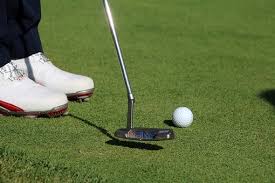Finding the best putters for high handicappers can be extremely challenging, as there are so many sizes, shapes, colors, weights, and other pieces of the puzzle to contend with, yet each are critically important to your short game.
Having an understanding of these different factors is critical when choosing the best putter for your play style and needs.
Having the proper putter will be a huge win for your short game and your overall enjoyment of golf, which is why we’ve dedicated this entire article to finding the best putters for high handicappers.
Take a look through our top picks and buying guide below.
Our Picks for the Best Putters for High Handicappers in 2020
| Our Top Pick for Best Putter for High Handicappers | TaylorMade Spider Putter |
| Best Steel Faced Putter for High Handicappers | Cleveland Golf Huntington Beach Putter |
| Best Value Putter for High Handicappers | Odyssey White Hot Pro 2.0 Putter |
| Best Putter for High Handicappers on a Budget | Pinemeadow PGX Putter |
| Best Budget Alignment Putter for High Handicappers | Pinemeadow PGX SL Putter |
| Best Budget Putter for High Handicappers Runner-Up | Wilson Staff Harmonized Putter |
| Best Alignment Improvement Blade-Style Putter | S7K Standing Putter |
TaylorMade Spider Putter

Chances are if you’ve watched golf on TV you’ve seen the TaylorMade Spider Putter. It’s sleek design, easy alignment, and stability make it a great choice for players with a more gentle stroke.
This is an excellent putter if your putts tend to pull to the right or if you find your putts have an uneven roll to them, as this putter offers an insert with recessed lines that reduces backspin and skidding.
Although it’s a little pricier than the other best putters for high handicappers we’ve reviewed here, the TaylorMade Spider Putter is a classic favorite that’s easy to use that will bring a definite impact to your short game.
Pros:
- Extended back makes this putter extremely easy to align
- Outstanding balance
- Very popular with Tour and amateur players alike
Cons:
- A little heavier than other mallet-style putters
- Some users have mentioned the paint will start scratching off with use
Cleveland Golf Huntington Beach Putter

Cleveland is, in our opinion, one of the most under-celebrated brands in golf. Cleveland’s short game equipment consistently gets high marks in our reviews.
Cleveland’s Huntington Beach Series Putters (including the Huntington Beach Soft Series) are reasonably priced, very forgiving putters and any model would be an excellent addition to any golfer’s bag.
These putters also come with a midsize golf grip, which helps high handicappers keep their hands from taking over their stroke too much.
Pros:
- Attractive pricing
- Very forgiving putters
- Wide variety of styles ensures you’ll find your perfect match
Cons:
- Not as “soft” as some other putters we’ve reviewed here
- Some players think these putters are too light
Odyssey White Hot Pro 2.0 Putter

The Odyssey White Hot Pro 2.0 Putter is a very popular putter and consistently ranks as one of the best putters for high handicappers, due to its durability, consistency, and premium feel.
This year’s iteration offers firmer inserts than previous models and provides an excellent roll on the green. The putter’s heel/toe weighting also adds to it’s excellent response and high forgiveness.
The White Hot 2.0 also nails it in the looks department, as it’s matte surface eliminates glare, and it’s simple lines make for easy alignment.
We’d recommend this putter to any high handicapper looking to add consistency and accuracy to their short game.
Pros:
- Great feel and response
- Very forgiving
- Simple design with matte finish
Cons:
- Takes a bit of practice to get used to
- No oversized grip option offered on this putter
Pinemeadow PGX Putter

Pinemeadow’s PGX is another top recommendation for best putters for high handicappers due to it’s absurdly low price and great value. Don’t let the lack of name brand recognition fool you – this is a highly-rated putter that has good weight balance and will help promote accuracy in your short game.
The white finish helps with contrast and alignment, however you may need to clean it a bit more often than other putters.
This mallet-style putter helps with control and the roll management will help you play better on faster greens, which are what you’re going to find on most golf courses.
Pros:
- Excellent value and low price point
- Good balance and weighting
- Contrast and design make alignment easy
Cons:
- White finish may not appeal to some golfers
- Some golfers find this putter heavier than others
Pinemeadow PGX SL Putter

Pinemeadow’s PGX SL is very similar to the PGX Putter in the sense that it’s extremely affordable and forgiving, making it a great choice for best putter for high handicappers.
The key difference in the SL is the offset “plumber neck” hosel and center balancing, both which help with alignment. The included Spider Grip is comfortable and offers high levels of shock absorption.
The two-orb alignment system offers additional easy alignment, while the face insert helps minimize skipping while promoting a smooth roll on the green.
Pros:
- Extremely affordable (just like the Pinemeadow PGX)
- Very easy to align
- Offset hosel provides additional forgiveness
Cons:
- Some players may find the looks of this putter a little garish (white and yellow-green)
Wilson Staff Harmonized Putter

Wilson’s semi-mallet putter, the Staff Harmonized Putter is kind of like a hybrid blade / mallet putter, which in our opinion is the best of both worlds.
Wilson cast this putter rather than having it milled, resulting in a putter that’s a little heavier and has a nice sound to it when struck. The plastic face insert helps create additional topspin than a typical metal-faced club while helping to minimize skipping.
Adding to this sleek and affordable putter is additional forgiveness from the included oversized grip, helping steady your hands during the stroke.
If you’re looking for a budget option and the PGX or PGX SL aren’t quite your speed, the Wilson Staff Harmonized Putter is an excellent choice.
Pros:
- Great feel
- Heavy club head promotes extra stability through the stroke
Cons:
- Some golfers don’t like the sound at impact (but we really enjoy it!)
S7K Standing Putter

When you hear the phrase “standing putter”, you’re likely to think “Well of course it’s standing! I wasn’t planning on making the putt while sitting!”. In reality, this putter can actually stand on it’s own, allowing you to take a step back and truly see how your shot will break and make important adjustments.
This blade-style putter is also interesting because it has the feel and weight of a mallet putter, and the heavier club head provides extra stability during the stroke for increased accuracy.
The wide, milled face also allows extra forgiveness (much needed by high handicappers), with easier control over speed and direction of putts.
Pros:
- Great premium-style design and feel
- Excellent control and feedback
Cons:
- Some golfers complain about the sound on impact (again, not a big issue for us here)
Best Putters for High Handicappers: Buyer’s Guide
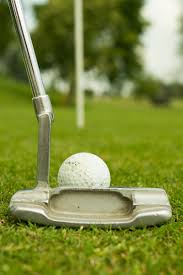
What To Look For In The Best Putters for High Handicappers
Head Design
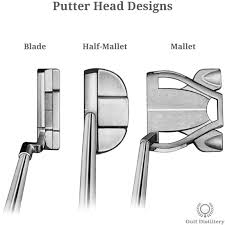
There are four styles of head designs for putters: blades, mid-mallets, mallets, and perimeter weighted.
Blade Putters
Blade putters are face-balanced putters with traditional-style long skinny putter heads which transfer less energy to the ball (due to their thinness), and are usually best for golfers who have a straight and faster putter stroke.
Perimeter Weighted Putters
Perimeter weighted putters (also known as heel-toe putters) are an evolution of the blade putter and are also similar in look to a blade putter. These toe-weighted putters’ designs add weight in the heel and toe sections in order to add more consistency and forgiveness.
Mallet Putters
Mallet putters have larger heads like those found in many of today’s modern drivers, which allow for more consistency and forgiveness and aid in alignment. The deep design of the mallet-style putter heads allow for a lower center of gravity, helping to reduce spin and provide more forgiveness on off-center putts.
Putter Faces and Inserts
Many of today’s modern putters have specially-design faces or even inserts on the putter face that aim to provide certain characteristics to the putter head, and which type you choose can really help you dial in the performance of your putter and match it to your play style.
There are three main types of putter faces available on the market today: metal-faced putters, insert-faced putters, and groove-faced putters. The type of face you should select is largely based on personal preference.
Metal Faced Putters
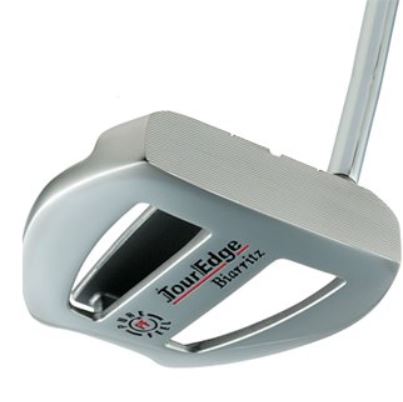
While most metal faced putters are traditionally made of steel, metal faced putters can also be made of zinc, titanium, aluminum, bronze, brass, and copper. These putters are well suited to high handicappers for their control and strong shot feedback.
Some metal faced putters may also have milling, or a pattern on the clubface that assists with providing better feel and sound.
Insert Faced Putters

Insert faced putters are traditionally metal putters that have a non-metal insert placed in the face of the club. The advantages of an insert faced putter are that the weight is moved to the heel and toe of the putter, which increase control and forgiveness, and that the insert will provide specific characteristics based on the type of insert and material used.
A common complaint of insert faced putters is that they don’t produce the sound (such as a “ting”) that metal faced putters offer.
Insert faced putters are great putters for high handicappers as they allow for players to dial in the performance of their putter for their play style while allowing them to use golf balls with firmer covers while offering the same “feel” of playing with softer golf balls.
Groove Faced Putters
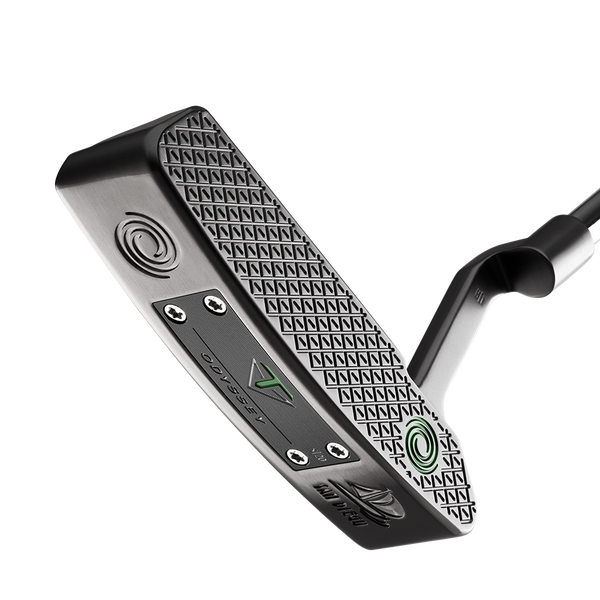
Groove designs and patterns on a putter’s face help to provide more forgiveness on off-center hits while promoting better roll, resulting in more accuracy. Most groove faced putters are metal in composition, however there are some insert faced putters that have also started to incorporate these groove patterns in the past several years.
Putter Length
You’re probably starting to get the idea that putters are highly personal in nature, and this is especially true when it comes to the important aspect of putter length.
It’s crucial that you are comfortable and can maintain a proper putting stance, and the height of your putter plays a big role in this. The standard putter length is 35 inches, but there are both shorter and longer options available.
Make sure to try out several lengths and get this dialed in for your height, posture, and play style – it WILL make a big difference and varies for each player.
Belly Putters
Belly putters have been gaining popularity for some time, and are different from traditional putters in length. They’re much longer (usually 41 to 44 inches in length) and allow the golfer to anchor the putter against their abdomen for extra stability in the putting stroke.
As all things go with putters be sure to test out a belly putter to see if it’s right for you.
Shaft Design
There are three types of putter shaft designs: heel, centered, and hosel offset.
Heel-Shafted Putters
These putters feature a hosel that connects directly with the putter head on the end that is closest to the player (called the heel of the putter). Players choose these putters for their ability to control the lie of the putter and prefer them for their feedback.
Center-Shafted Putters
These putters have a hosel that connects to the club head in the head’s center and work best for players who tend to have straighter putt strokes.
Offset Putters
Offset putters have a hosel that bends to move the putter’s shaft ahead of the putter face to keep the golfer’s hands ahead of the ball all the way through impact on their stroke.
Offset putters are generally the most recommended putters for high handicappers as they keep the wrists steadier than other putter types.
Your mileage may vary with these different styles, and you should absolutely try out each putter shaft type to make sure to find your best fit.
Shaft Weight
The weight of your putter’s shaft works in tandem with the length of your putter, so it’s important to find the proper balance between the two. We don’t recommend simply going shorter on the shaft to reduce weight, as this will throw off other aspects of your putt.
A good way to dial in the proper weight is by beginning with a putter that’s the proper length and may feel slightly lighter than you prefer, then using putter weights to dial in the exact weight that feels right to you.
Putter Balance Point
There are two main balance styles of putters: face balanced and toe balanced.
You can determine which type you’re looking at by balancing the shaft on your finger: if the face points upwards, you’ve got a face balanced putter. If the toe points toward the ground, you’ve got a toe-balanced putter.
Face Balanced Putters
These putters’ centers of gravity are directly below the shaft, and are best for players with a straight putting stroke as they will offer less movement on the backswing and follow-through of the putt stroke.
Toe Balanced Putters
Toe balanced putters will offer more opening and closing throughout the putting stroke due to their off-center gravity and are recommended to players who have an arcing putt stroke.
Lie Angle
Simply put, the lie angle of your putter is the angle from the putter’s sole to the putter’s shaft. The most common lie angle of today’s putters is between 70° and 72°, while older putters tend to go 72° and higher.
You’ll want to experiment here, as using an incompatible lie angle may cause accuracy issues in your putt.
Loft
Loft is the angle that the face of the putter lies relative to a perfectly vertical line. The proper loft angle really varies by each player and their stroke style.
Too much loft can result in the ball coming up off the putter face at impact, making it difficult to control your putt’s distance, while too little loft can press the ball into the turf, causing skips or skids and creating control and/or distance issues as well.
Moment of Inertia (MOI)
We won’t get too deep into MOI here, but ultimately the higher MOI your putter offers, the more forgiveness you’ll have on off-center hits. That forgiveness means you’ll keep more distance and better control in your putt.
Consider the fact that high handicappers are three times less likely to hit the sweet spot on a putt compared to single digit handicappers, and you’ll understand why having a high MOI putter is so important!
Putter Grip
Putter grips come in a variety of sizes, shapes, and textures. Don’t overlook grip, as it plays a big role on your performance – it’s very important to choose the best grip for your play style.
Many players lean toward a thicker grip for it’s comfort factor, while counterbalanced grips offer weighting below the hands which helps players with active wrists effectively “quiet” them better.
Comfort
Comfort plays a critical role in your putt. You should feel properly lined up and also notice that the putter sits comfortably behind your ball without any foreign adjustments or movements.
Budget
There’s a wide range in price points of the best putters for high handicappers, and the more you spend on a putter means that’s less you’ll have for additional equipment or getting out and playing a round on the course.
We’ve purposely selected putters for multiple budget options in our roundup here so that every golfer can get an excellent putter at their desired price point.
Popular Brands of Putters
There are many brands offering excellent putters out there – here’s a quick breakdown of some of the best putter brands available today:
- Cleveland Golf: well known for their wedges, short game equipment, and their Launcher line of clubs
- TaylorMade: a constant innovator in the driver category and manufacturer of one of our top picks for best putters for high handicappers, the Spider Putter.
- PING: An iconic manufacturer that’s lauded by both pro and amateur golfers worldwide
- Odyssey: The top manufacturer of putters, known for innovation and instantly recognizable putters
- Wilson: provides a full line of golf equipment in both pricey and budget options
Best Putters for High Handicappers: Frequently Asked Questions
Should I Use A Mallet Or A Blade Putter?
This really depends on your play style. If you have a pronounced arc to your stroke, a blade putter is the way to go, as these putters are best suited to players with quiet hands and hit the middle of the putter face on most of their shots.
Mallet putters have larger sweet spots and provide more forgiveness, which is why we generally recommend mallet putters for most high handicappers.
Should I Use An Offset Putter?
Most pros and club fitters will tell you to reference your dominant eye when deciding on an offset putter.
If your lead eye is dominant (so your left eye if you’re a right-handed golfer), then you’ll want to stick to a straight-shafted putter. If your right eye is dominant (if you’re right-handed), you’ll want to try a half or full-offset putter.
As always, putters are a very personal thing and you may find that eye dominance has no effect on what type of offset – if any – you prefer, so be sure to experiment to find your best fit.
What Putter Length Do I Need?
You’ll want to experiment with different putter lengths, as the typical length of a putter is between 33”-35” long. Just be sure not to fall into the trap of using a putter that’s too long for your body, as this can cause accuracy problems.
What Type Of Grip Should I Use On A Putter?
We keep saying it, but putting and all things surrounding it are largely a matter of preference! It may take some experimenting to find the best match for you.
As a general rule, if you find yourself pulling or pushing putts, try out a midsize or jumbo grip to straighten them out.
Does My Putter Brand Name Matter?
Brand name does not matter when choosing a putter. Length and feel of your putter matter most here.
Don’t let fancy marketing or flash brand names influence your decision, try to really feel out your putter and make sure it is comfortable and the weight and length feel best to you.
How Long Do Putters Last?
Putters can last an entire lifetime, but technology seems to surpass the putters themselves at least every decade (if not sooner). Make sure you’re not falling for the newest hype every, and you’ll be fine.
How Much Should I Spend On A Putter?
Putter prices can reach far and wide, going from as low as $30 to over $500 for a premium putter. We’re not saying you need the highest-end putter available, but you really do want to spend money on the specific putter that feels the best to you, as you’re going to make more shots with your putter than that expensive driver in your bag.
A great way to save on a high-end putter is to look at the past few years’ top models and select from there – that way you still get what is relatively high-end tech and features at a lower price.
What’s The Difference Between A Face-Balanced Putter Versus A Toe-Balanced Putter?
You can determine which type you’re looking at by balancing the shaft on your finger: if the face points upwards, you’ve got a face balanced putter. If the toe points toward the ground, you’ve got a toe-balanced putter.
Face Balanced Putters
These putters’ centers of gravity are directly below the shaft, and are best for players with a straight putting stroke as they will offer less movement on the backswing and follow-through of the putt stroke.
Toe Balanced Putters
Toe balanced putters will offer more opening and closing throughout the putting stroke due to their off-center gravity and are recommended to players who have an arcing putt stroke.
What Are Groove Faced Putters?
Groove designs and patterns on a putter’s face help to provide more forgiveness on off-center hits while promoting better roll, resulting in more accuracy. Most groove faced putters are metal in composition, however there are some insert faced putters that have also started to incorporate these groove patterns in the past several years.
Should I Have A Club Fitting For My Putter?
Considering that you’ll use the putter more than any other club in your bag, we feel that if you’re going to spring for a club fitting, the putter is the most deserving! At the same time, we generally recommend lessons over club fittings for players on tight budgets.
Curious about what to expect in a club fitting? Check out our guide to the club fitting process while you’re here.
Wrapping Up Our Reviews and Guide to The Best Putters for High Handicappers
Clearly, there’s a lot to consider when selecting the best putter for high handicappers- luckily, there’s no shortage of excellent choices either! We hope you’ve found this guide helpful – please feel free to leave any questions or comments below.
If you’re a high handicapper looking for other gear recommendations, be sure to read through our picks for the best golf balls for high handicappers, best drivers for high handicappers, and the most forgiving irons of 2020.
If you’ve already got your perfect gear setup, make certain to brush up on how to get the perfect golf stance and our reviews of the best indoor putting greens to make the most of your clubs!

